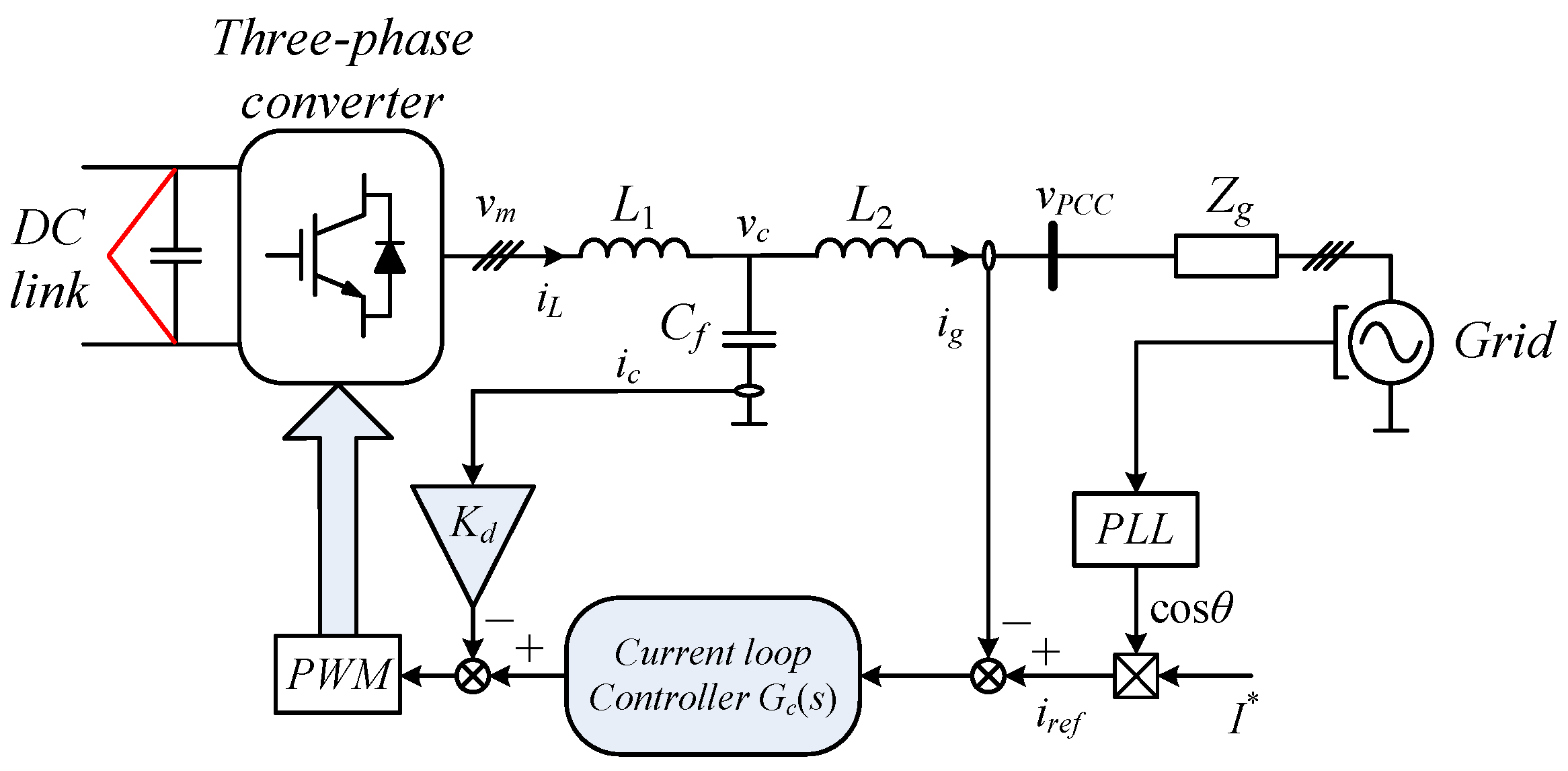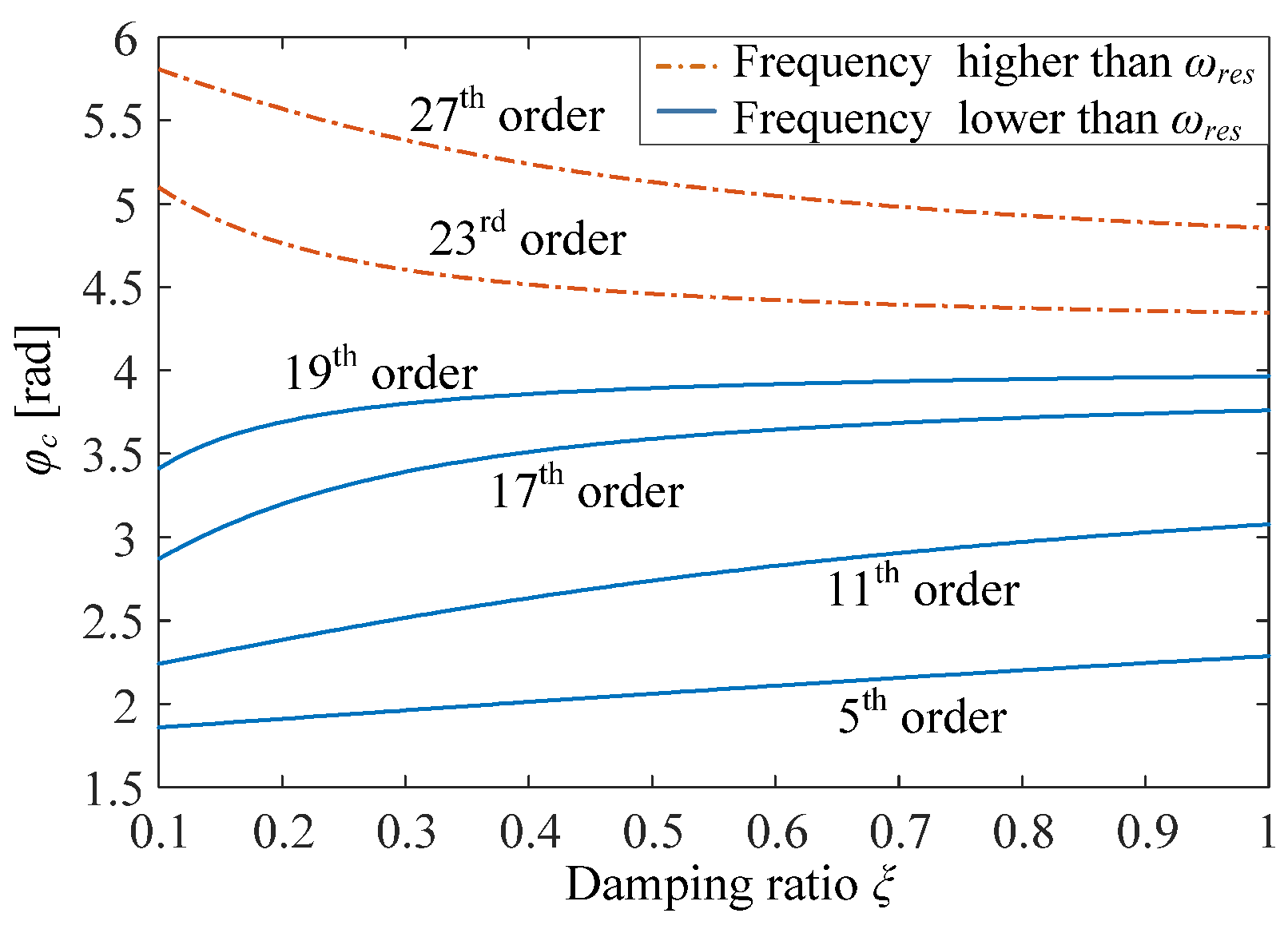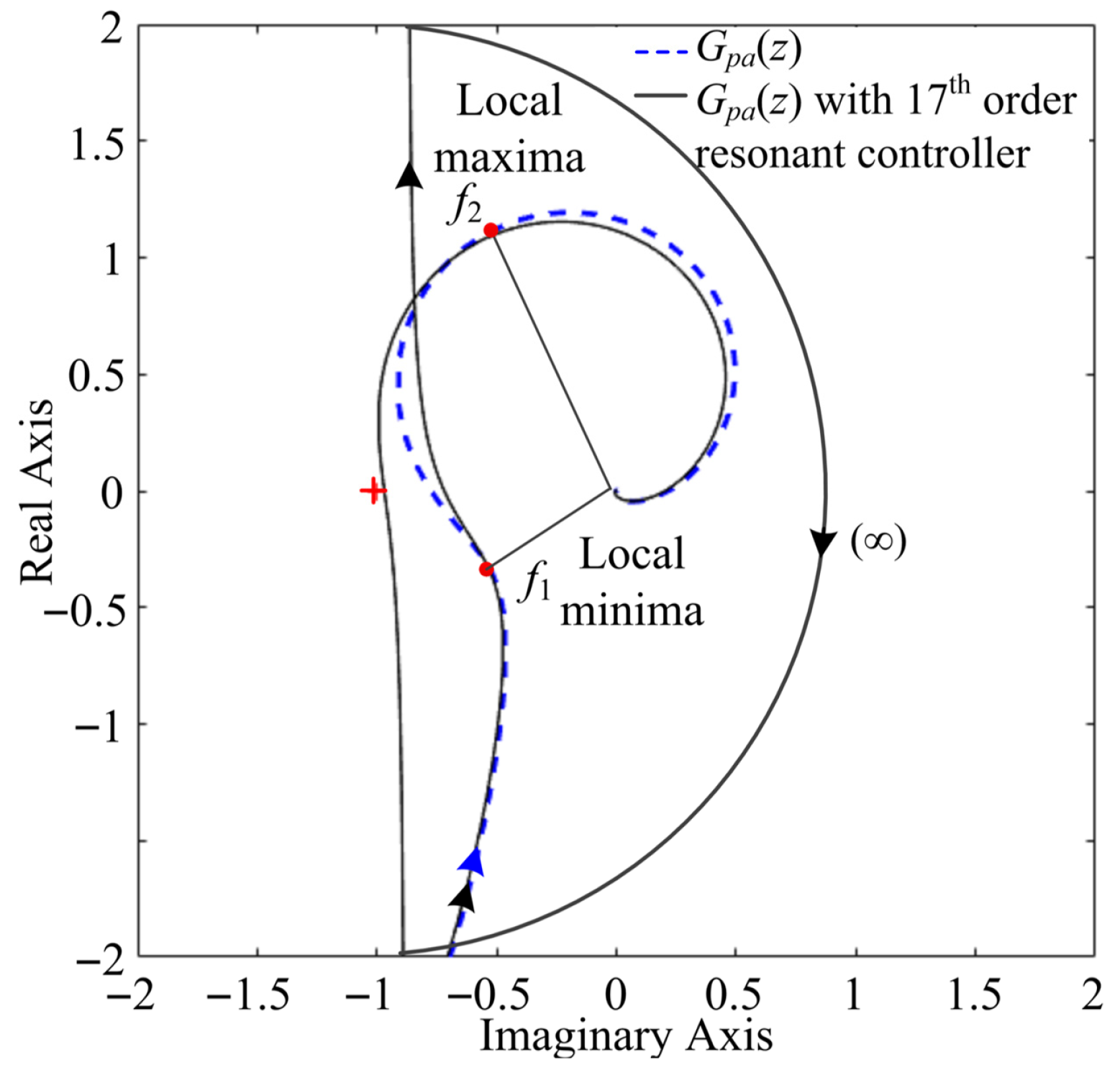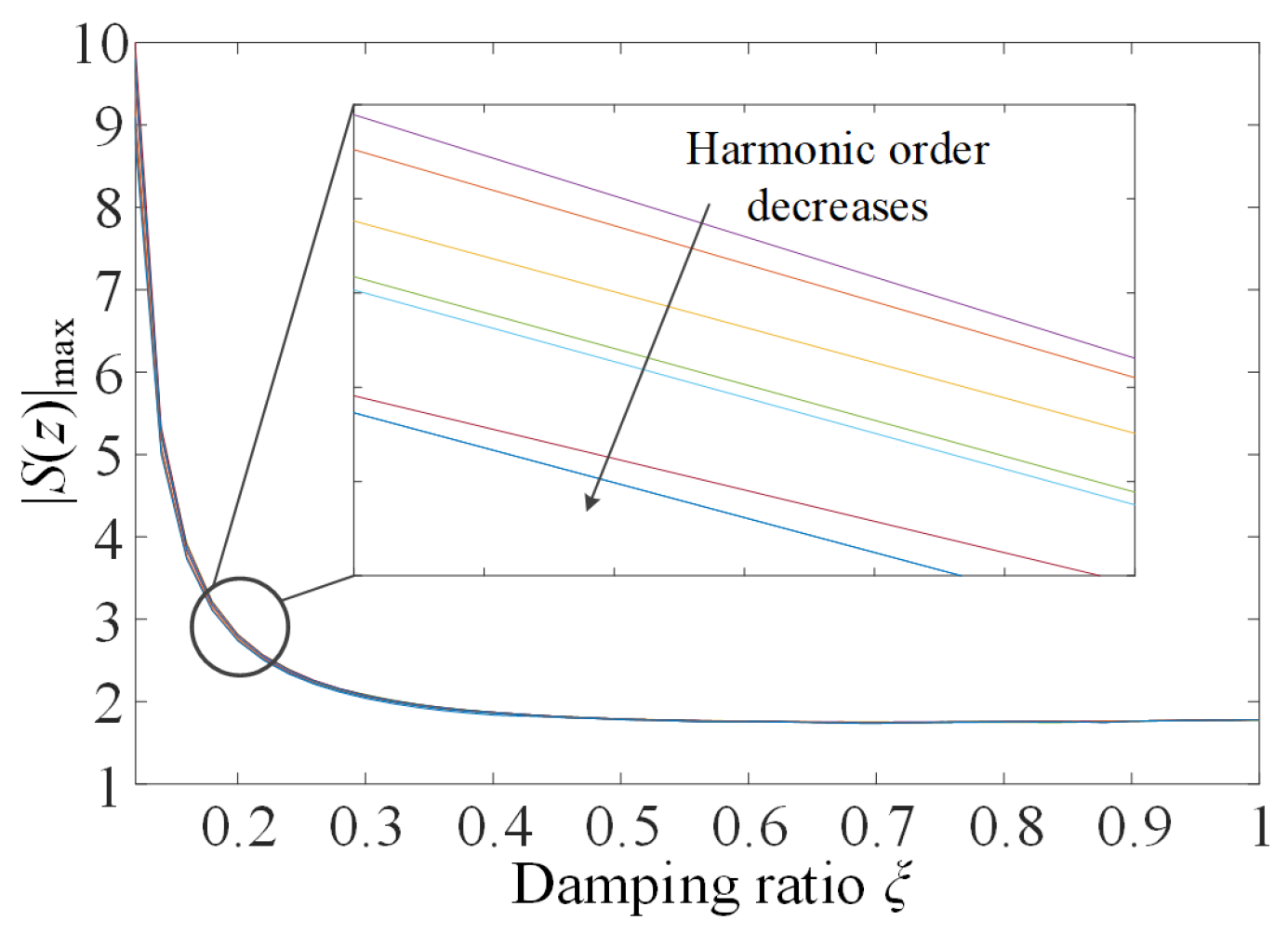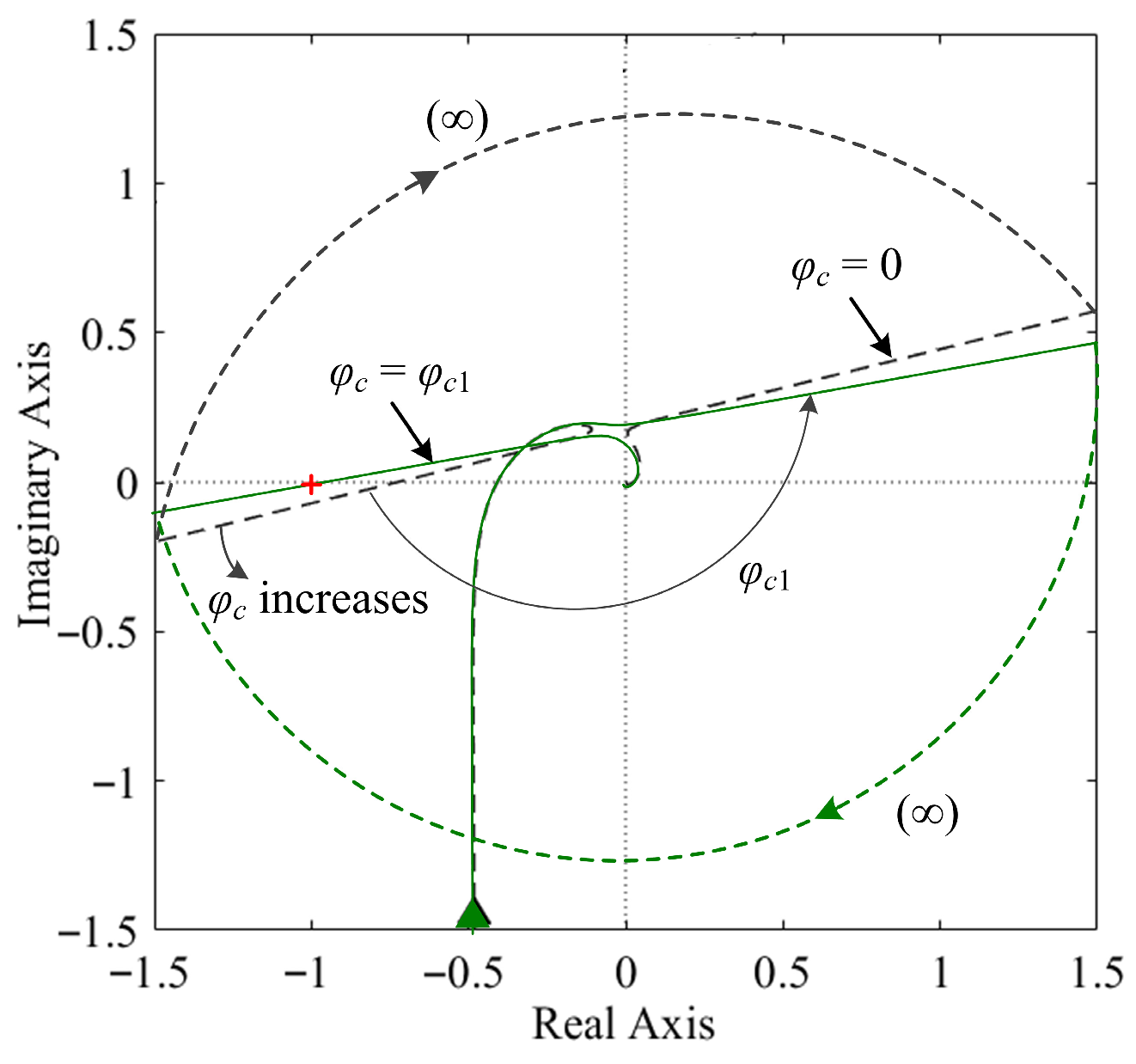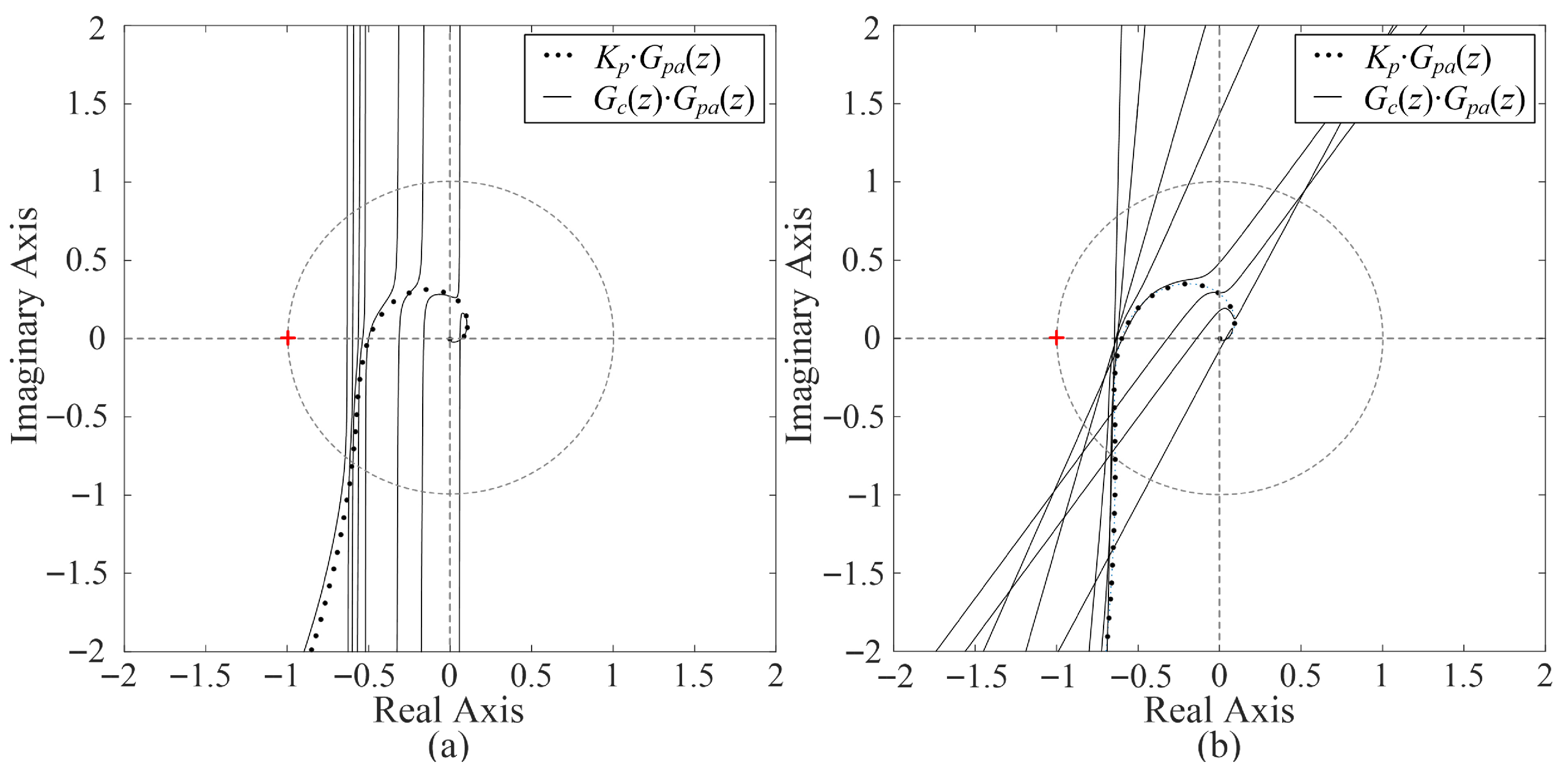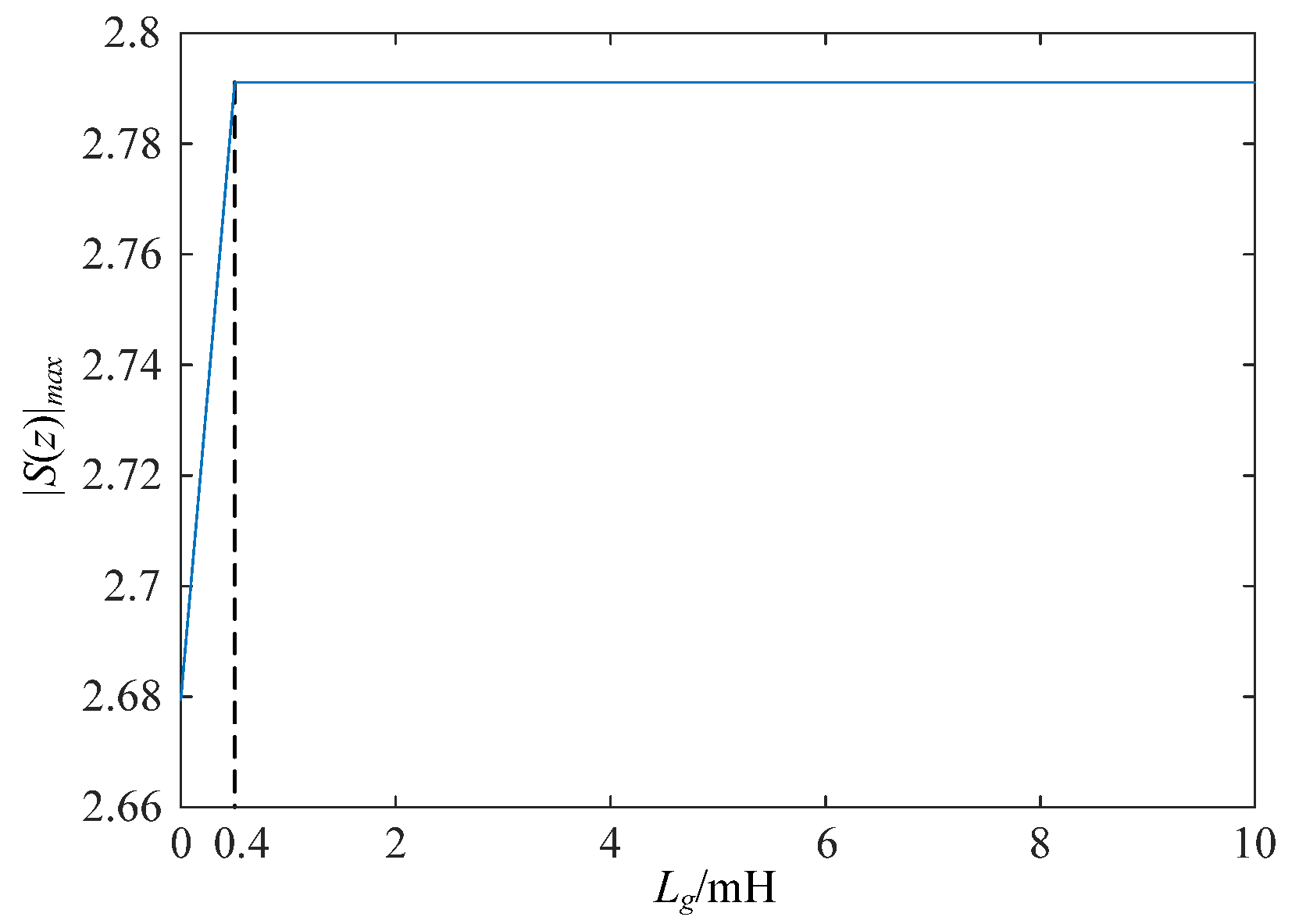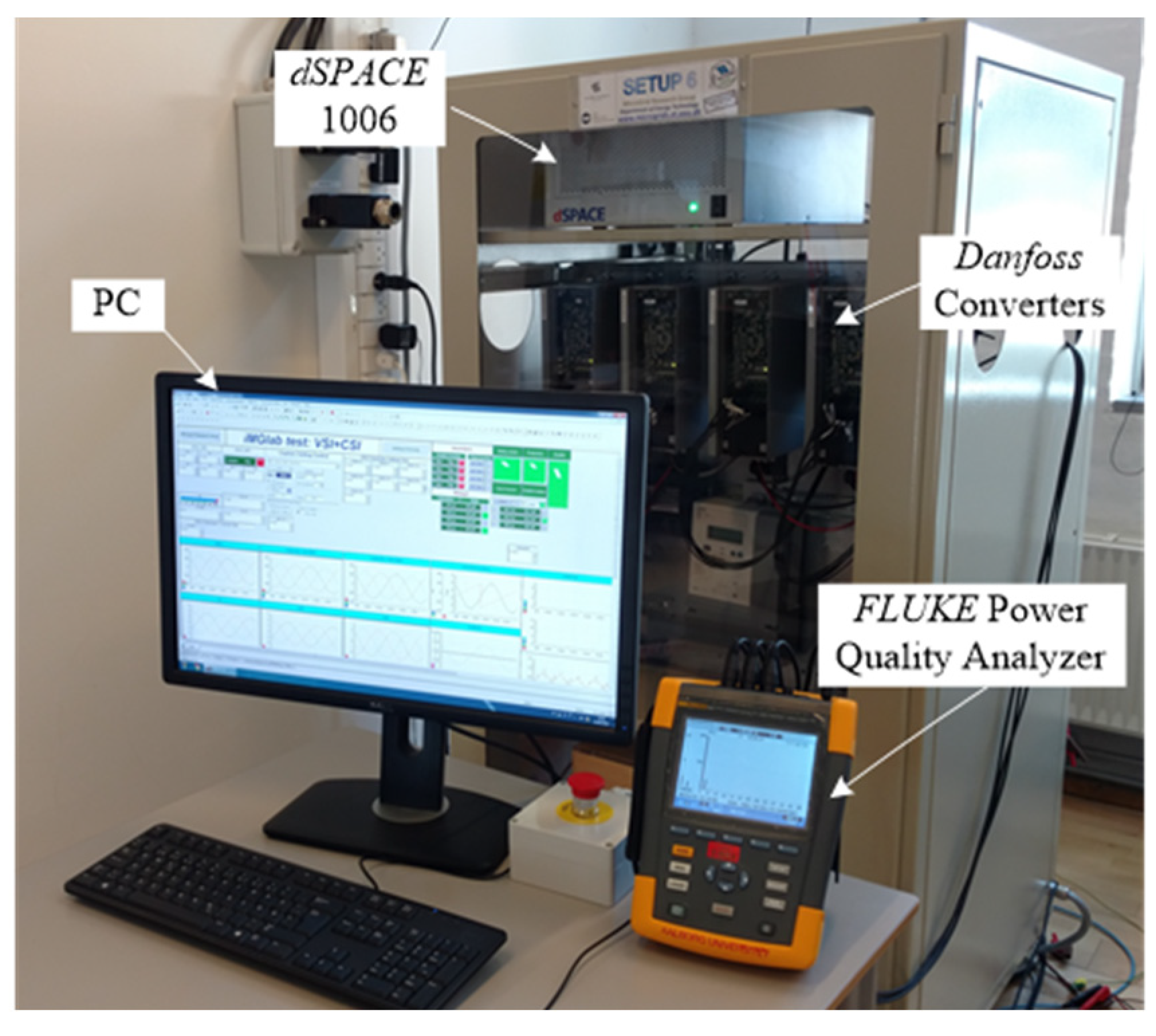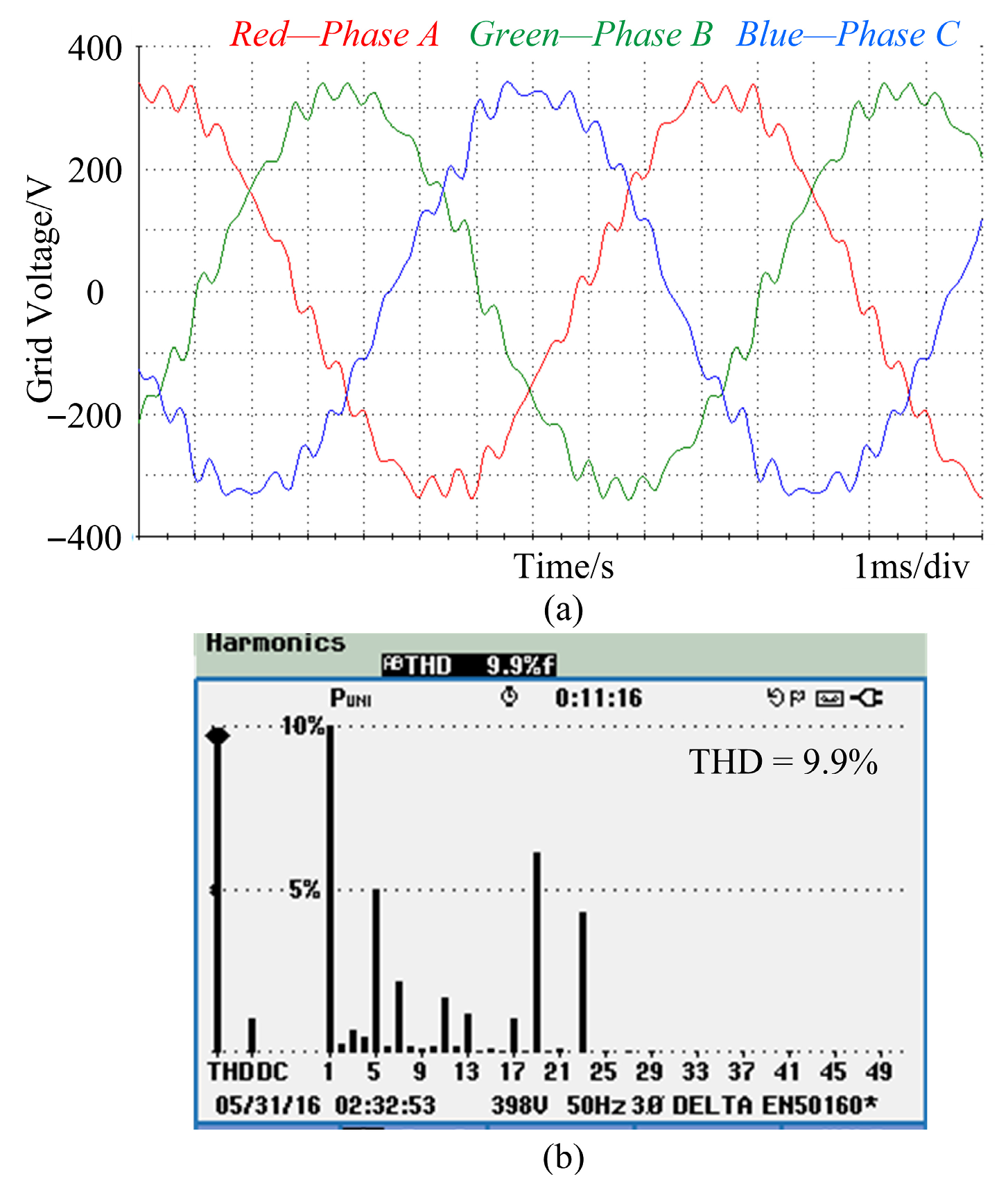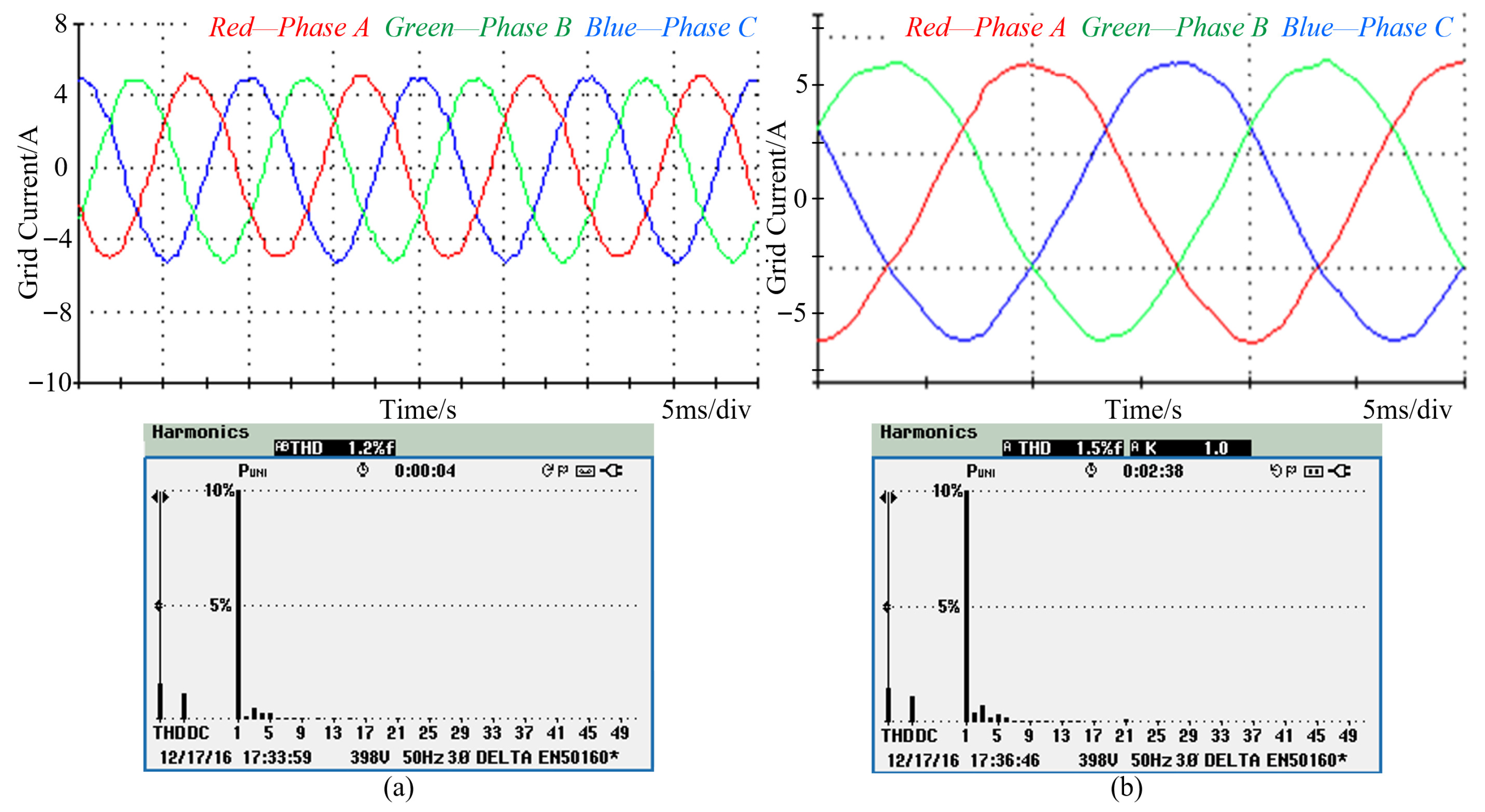1. Introduction
Driven by economic and environmental issues, dispersed energy resources (DERs), such as wind turbines (WT) and photovoltaic (PV) arrays, are combined with advanced power electronics systems and integrated into power grids [
1,
2,
3]. Power electronic converters play an active role in distributed power generation, as they bridge the DERs and the power grid. Generally, pulse width modulation (PWM) is commonly used to generate switching signals for converters. However, a principal disadvantage of this methodology is the inherent generation of high-order harmonic content, predominantly at the switching frequency and its multiples, thereby causing a deterioration in grid power quality. To mitigate these high-frequency harmonics, an
L-type or
LCL-type low-pass filter is usually implemented between the converter and the grid to provide necessary attenuation.
Compared with the
L-filter, the
LCL-filter can provide better high-frequency harmonic attenuation with the same value of inductance [
4,
5,
6,
7]. However, along with the advantages that the
LCL-filter brings, the well-known resonance peak and 180° phase jump are also induced, which make the controller design more challenging [
8,
9,
10,
11,
12,
13,
14,
15,
16,
17].
One of the easiest ways to damp the
LCL-filter resonance peak is by simply inserting a resistor in series with the filter capacitor [
8]. In this way, the filter resonance peak can be damped at the expense of reduced system efficiency. In order to avoid the power losses caused by the damping resistor, so-called active damping [
7,
9,
10,
11,
12,
13,
14] is proposed by feeding back measurable electrical variables into the control loop to adjust the system damping factor, e.g., capacitor current feedback.
Previous research has explored various design strategies for
LCL-filters and control loops. For instance, ref. [
11] investigates the influence of system delays on capacitor current feedback active damping and improves robustness against grid impedance variations by aligning the capacitor current sampling instant with the PWM reference update. Furthermore, refs. [
12] introduces a delay compensation method to ensure system stability. Building on this, studies [
13,
14] demonstrate that directly reducing system delay through the multi-sampled PWM (MS-PWM) method can maintain robust stability up to twice the switching frequency.
The aforementioned strategies can enhance the system robustness against grid impedance variations. However, the inherent 180° phase lag introduced by the filter resonance frequency necessitates setting the system crossover frequency well below the resonance frequency to maintain an adequate phase margin [
11,
12,
13]. This design constraint, in turn, degrades the system’s performance in rejecting or injecting high-order harmonics. In order to enhance the high-order harmonic tracking capability, passivity-based and virtual RC damper-based controller tuning strategies are proposed in [
15] and [
16], respectively. Meanwhile, by carefully designing the
LCL-filter parameters, a shunt active power filter (SAPF) is designed in [
18] and [
19] respectively to effectively compensate high-order harmonic currents without triggering system instability issues. In [
20,
21], simplified resonant controller tuning strategies are proposed with enhanced performance. In [
22], bilateral Bode plots are utilized to optimize the phase leading angle of the resonant controller under low-carrier-ratio conditions.
However, the above-mentioned controller and LCL-filter design strategies lack detailed analysis regarding the influence of the system damping ratio on the controller design principle, and the harmonic controller is generally required to be tuned below the filter resonance frequency to ensure system stability. This results in the converter lacking the controllability of high-order harmonics (adjacent to and higher than the filter resonance frequency), which is undesirable in applications with a low LCL-filter resonance frequency (e.g., several hundred hertz in high-power applications [
23]). It is also worth noting that in [
16], harmonic compensation up to the 43rd order (2.15 kHz) is achieved by tuning the LCL-filter resonance frequency to 2.6 kHz, which is still much higher than the central frequency of the highest-order resonant controller.
Moreover, grid impedance variation is also a critical issue for harmonic compensation, since it may cause resonance frequency reduction. Conventionally, this issue is resolved by compromising harmonic control capability, i.e., by avoiding tuning harmonic controllers close to the
LCL-filter resonance frequency [
16,
17,
18,
19]. Although this approach can keep the system stable, the current quality may be degraded, since high-order harmonics remain uncontrolled. Furthermore, considering wide-range grid impedance variations in weak grids, the highest frequency of the controlled harmonic current should be further decreased, which will lead to the deterioration of current quality. It is worth noting that previous works are validated across diverse grid scenarios (e.g., frequency variations and load changes). This paper presents a theoretical analysis with validation under a defined set of conditions. An exploration of the proposed method under diverse grid scenarios is planned for our future work, including a more comprehensive analysis of its performance.
In light of the above-mentioned issues, it is proposed in this paper that by coordinating the system damping ratio and the phase leading angle induced by the resonant controller, the central frequency of the resonant controller can be tuned above the filter resonance frequency without triggering instability issues, even with wide range of grid impedance variations. Consequently, high-order harmonics can be suppressed, which leaves the grid current with improved power quality. The rest of the paper is organized as follows: Section II gives a detailed system characteristic analysis, while Section III illustrates the proposed controller design method. Experimental results are analyzed and discussed in Section IV. Finally, Section V presents the conclusion of the paper. Part of this paper was presented at the IEEE Applied Power Electronics Conference and Exposition [
24]. Compared to prior work, this paper adds a comprehensive analysis of the resonant controller compensation capabilities, an in-depth stability analysis of the system, and a detailed performance evaluation of the proposed controller.
2. System Modeling and Analysis
The system under study, which is a general case of an
LCL-filter-based grid-connected system, is shown in
Figure 1. The grid is represented by its Thévenin equivalent, comprising an ideal sinusoidal voltage source in series with a grid impedance
Zg.
L1,
L2, and
Cf denote the converter-side inductor, grid-side inductor, and filter capacitor, respectively, while
vm,
vc,
iL, and
ig represent the converter output voltage, capacitor voltage, converter-side current, and grid-injected current, respectively.
A phase-locked loop (PLL) is employed to synchronize the current reference iref with the grid voltage vg. Resonance damping is achieved through capacitor current feedback active damping. It should be noted that the outer DC voltage control loop—which generates the active current reference I*—is not addressed in this paper, as its bandwidth is significantly lower than that of the inner current loop, rendering their dynamic interaction negligible in this context.
By neglecting the parasitic parameters of the
LCL-filter, the power plant model is illustrated in
Figure 2. The s-domain transfer function from
vm to
ig is then shown in Equations (1) and (2).
where
Kd denotes the capacitor current feedback gain,
ξ denotes the damping ratio, and
ωres denotes the
LCL-filter resonance frequency. From Equation (1), it can be seen that by properly tuning the feedback gain
Kd, a second-order system with the desired damping ratio can be obtained. The system parameters used both in the analysis and the experiments are listed in
Table 1.
Figure 3 shows the Bode plots of
Gpa(
s) with different damping ratios. As observed, while the resonance peak is effectively damped, a 180° phase shift is simultaneously introduced. For frequencies below
ωres, the phase response starts at −π/2 and decreases monotonically to −π at the resonance frequency. Consequently, conventional design principles mandate that the highest controlled harmonic frequency must not approach
ωres to ensure sufficient phase margin.
At frequencies above ωres, the phase further decreases from −π, eventually reaching −3π/2. Given this characteristic, controlling harmonics beyond the resonance frequency appears infeasible with common compensation methods (e.g., lead–lag compensation); consequently, few publications have addressed this challenge. Furthermore, non-negligible PWM and computational delays introduce additional phase lag, causing the system phase at high frequencies to fall below −3π/2. This further complicates the control of harmonic currents at frequencies exceeding ωres.
Assuming the current controller is implemented in the
αβ frame with the following expression:
where
kpi and
τ are the proportional coefficient and integral time constant, respectively, and
ωf is the fundamental angular frequency.
The controller parameters can be designed as [
25]
where
fc is the crossover frequency and
r and
rg are the parasitic resistance of the filter inductor. Considering the 180° phase shift induced by the
LCL-filter,
fc should be 0.3 times smaller than the filter resonance frequency to avoid instability issues.
Apart from fundamental current tracking, harmonic controllability is also a critical issue for grid-connected converters. Generally, multiple parallel resonant controllers [
26] are adopted to provide high gains as well as compensate for system delays at desired harmonic frequencies. The controller can be expressed as
where
kres is the resonant controller gain,
n is the highest harmonic order that can be compensated,
h is the harmonic order that needs to be compensated for, and
φc is the induced phase leading angle at the resonant frequency. Conventionally, the value of
nωf is required to be sufficiently lower than
ωres to avoid instability issues caused by the system phase lag. Note that a synchronous reference frame phase-locked loop (SRF-PLL) is employed to update the center frequency of the resonant controller. The PLL bandwidth is set to 10 Hz to achieve a suitable trade-off between tracking speed and noise immunity, thereby ensuring stable estimation of the frequency and phase angle for the controller. As the PLL serves primarily to adjust the center frequency of the resonant controller, its detailed design—being well-established in the literature [
27]—is not addressed in this paper.
Then, the system model is depicted in
Figure 4. In the figure,
Gdelay(
s) is the time delay induced by calculation and the PWM process and
Gc(
s) is the current loop controller which includes both
Gcf(
s) and
Gresd(
s). Consequently, the open-loop transfer function of the system is derived as
Normally,
φc is tuned to be equal with the inverse of the system phase angle [
28] to achieve a high compensation accuracy and stability margin, as shown in Equation (8).
Considering that
Gpa(
jhωf) is a function of
ξ, the relationship between
ξ and
φc is plotted in
Figure 5 for different harmonic frequencies. From
Figure 5, it can be found that the damping ratio has different influences on the phase leading angles at different harmonic frequencies. For the harmonics with a frequency lower than
ωres, the changing trend of leading angles versus the damping ratio tends to increase. Meanwhile, the trend becomes opposite for the harmonics with a frequency higher than
ωres.
In the conventional controller design method, ξ is selected before designing resonant controllers. Thus, the system phase delay is fixed and φc can be obtained directly from Equation (8). Under this condition, the influence of different ξ on φc and the system stability margin is neglected. Thus, to enhance system stability and harmonic controllability, the influence of ξ and φc on system stability should be analyzed. It is found that by properly coordinating ξ and φc, it is possible to control high-order harmonics even if their frequency is higher than ωres.
Moreover, the resonant controller with phase compensation is utilized in the control loop to add a control freedom to the system phase angle, and to the best of the authors’ knowledge, detailed analysis regarding phase compensation range of the resonant controller was not presented in detail in the previous publications. Thus, it is critical to examine the limit of the leading angle before designing the controller parameters.
From the transfer function shown in Equation (6),
Gresd(
s) can be grouped in the sets of
Table 2 based on the signs of sin
φc and cos
φc, and the corresponding pole/zero (PZ) map and Bode diagram are depicted in
Figure 6. Before analyzing the phase characteristic of
Gresd(
s), it is worth mentioning that a right-half-plane (RHP) zero will induce a
π/2 phase lag to the phase characteristic, while a
π/2 phase lead is induced if a left-half-plane (LHP) zero is presented [
29]. The initial phase angle of
Gresd(
s) is determined as:
From Equation (9), it can be seen that a positive sin
φc will set the initial phase angle as
π, while a negative sin
φc will set the system initial phase angle as 0. In a similar way, positive and negative signs of cos
φc will drive the system final phase angles to be −π/2 and
π/2, respectively. Thus, with different combinations of zero positions and
φc values, different phase responses of the resonant controller can be obtained. For instance, the signs of sin
φc and cos
φc are both positive for group A. Consequently, the phase response of
Gresd(
s) in group A starts from
π and ends at −π/2. Meanwhile, due to the RHP zeros in group A, a
π/2 phase lag is induced, and this phase lag allows the phase angle at the resonant frequency to be flexibly reduced by tuning
φc. This phase reduction results in the phase lead at the resonant frequency lying in the range of (0,
π/2) for group A:
Similarly, the phase lead at the resonant frequency for groups B, C, and D lies in the range of (π/2, π), (π, 3π/2), and (3π/2, 2π), respectively. Based on the above-mentioned analysis, phase lead provided by the resonant controller can cover a range from 0 to 2π.
Moreover, this conclusion can also be verified by the Bode diagram shown in
Figure 6b, which includes the four groups of resonant controllers. This important feature lays the theoretical foundation for delay compensation for harmonics higher than the
LCL-filter resonance frequency, where the phase angle of the power plant is below −π.
4. Experimental Results
The proposed control strategy was validated through experimental studies performed on the platform shown in
Figure 15. The setup comprises two 2.2 kVA Danfoss converters in a three-phase three-leg configuration with
LCL-filters. One converter acts as the current-controlled converter under test, while the other emulates the grid. The power stage and control system specifications are provided in
Table 1 and
Table 3, respectively. A dSPACE 1006 system was used for control implementation, and a FLUKE 437-II power quality analyzer was employed to monitor harmonic performance. Note that the Fluke 437-II complies with the IEC 61000-4-7 standard [
30], and the measurement accuracy for voltage and current harmonic amplitudes is specified as ±(0.1% +
n × 0.1%).
The computational burden of parallel resonant controllers can be alleviated through the following approaches if a processor with limited computational power is utilized: First, implementing the controller in the synchronous reference frame allows both positive- and negative-sequence harmonics of each harmonic pair to share the same frequency, enabling them to be regulated simultaneously by a single resonant controller. Second, a down-sampling technique can be applied, which lowers the execution rate of the controllers while maintaining the original sampling rate of the system, thereby halving the computational load per cycle compared to a full-rate implementation [
31]. Third, the use of a reduced-order resonant controller—replacing the standard second-order integrator with a first-order structure—further decreases computational requirements.
The controller performance is evaluated under a highly distorted grid condition, with the corresponding voltage waveform and frequency spectrum depicted in
Figure 16a,b, respectively. The grid voltage is characterized by multiple harmonics, notably extending up to the 23rd order. This is a critical test case, as these harmonic frequencies lie above the resonance frequency of the
LCL-filter.
Due to the proximity of the 19th- and 23rd-order harmonics to the
LCL-filter resonance frequency, the conventional controller cannot provide adequate compensation. Consequently, the grid current contains significant high-order harmonic content, as shown in
Figure 17. The total current THD is maintained at a relatively low level of 2.1%, as low-order harmonics are well compensated. In comparison, the proposed design strategy achieves satisfactory elimination of these high-order current harmonics, even when the harmonic voltage frequencies exceed the
LCL-filter resonance frequency.
To evaluate the performance and robustness of the proposed controller design, experiments were carried out under varying grid impedance conditions.
Figure 18 shows the grid current and its spectrum when all harmonics are compensated under two grid impedance values:
Lg = 0 and
Lg = 8 mH. As shown, compensation for the 19th- and 23rd-order harmonics yields a sinusoidal grid current. The corresponding THD values drop to 1.6% for
Lg = 0 and 1.4% for
Lg = 8 mH, respectively.
As illustrated in
Figure 18b, the system remains stable even when the grid impedance increases from 0 to 8 mH, demonstrating strong robustness against wide-range grid impedance variations. It is particularly noteworthy that the
LCL-filter resonance frequency in this case is as low as 800 Hz, which is well below the frequencies of the compensated 17th (850 Hz), 19th (950 Hz), and 23rd (1150 Hz) harmonics, further highlighting the effectiveness of the proposed method under challenging conditions.
Moreover, to evaluate the harmonic mitigation performance under conditions where the harmonic frequency is lower than the filter resonance frequency, a comparative analysis between the conventional and the proposed phase-leading angle strategy is provided in
Figure 19. Note that in this scenario, the 19th- and 23rd-order voltage harmonics are removed. As can be seen, the conventional method achieves a lower grid current THD of 1.2%, compared to 1.5% for the proposed method. This difference occurs because the conventional compensation angle closely matches the converter phase lag. However, the crucial advantage of the proposed strategy lies in its ability to effectively compensate for harmonics with frequencies higher than the filter resonance frequency, as demonstrated in
Figure 18.
The dynamic performance of the system was assessed by applying a current reference step from 3 A to 6 A. As shown in
Figure 20, the grid current reaches steady state within about one cycle.
Furthermore, the influence of compensation angle
φc23 on system stability is also assessed by conducting another experiment regarding
φc23 step changes. The resulting grid current waveforms are shown in
Figure 21. As expected, grid current oscillations occur after
φc23 decreases from 4.6 to 2.5, confirming the theoretical prediction that this setting leads to an unstable system.
